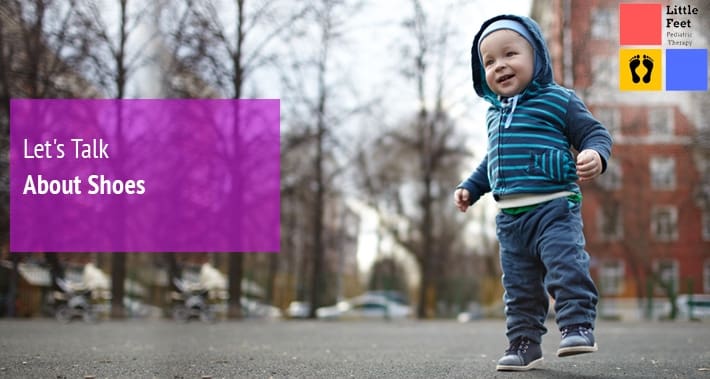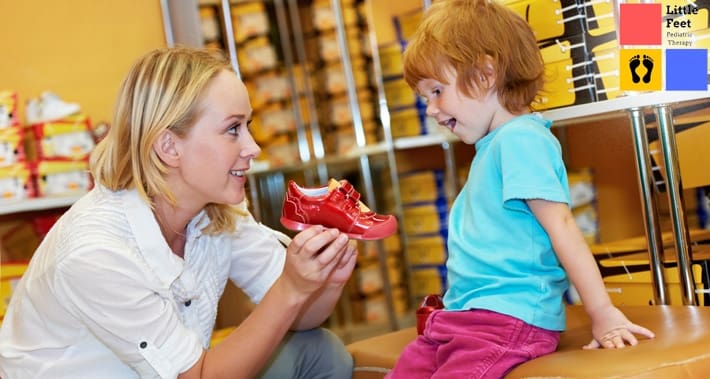
Purchasing your child’s first pair of shoes can be an exciting milestone.
It signifies the end of your child’s infancy and the start of toddlerhood.
However, putting your child in their first pair of shoes can also cause a significant amount of stress.
After all, there’s a lot to consider when purchasing a pair of shoes for your young child.
Trying to find the right pair to best support the continued development of their feet may seem like a herculean task.
Fortunately, pediatric physical therapy near me can help.
At Little Feet Pediatric Therapy, we want to help ease some of your sneaker stress.
So, we’ve put together this article to help explain some of the most important factors to take into consideration before buying your child’s first pair of shoes.
Keep reading to learn more.
Is Walking Barefoot Bad For Kids?
If your child hasn’t yet begun walking, you might be wondering if shoes are even necessary.
Babies don’t start developing an arch in their feet until they’re two years old.
Therefore, most children won’t require their first pair of shoes until they begin learning to walk.
Being barefoot is actually important for your child’s development.
Have you ever noticed that your baby’s feet are always in motion when rolling, crawling, and playing?
This is because babies develop and strengthen the muscles in their feet through barefoot play.
Putting your child into shoes too early limits their opportunities to strengthen their muscles and develop their fine motor skills in their feet.
RELATED: Pediatric Occupational Therapist Near Me
When Should Your Child Wear Their First Shoes?
If your child is beginning to walk independently, it’s a good indicator that they’re ready for their first pair of shoes.
As we previously mentioned, infants greatly benefit from barefoot play.
Therefore, it’s a good idea to hold off on buying your child their first pair of shoes until they begin walking.
Even when they begin walking, it’s a good idea to keep them barefoot inside and only use the shoes outside of the house.
Of course, sometimes booties are a good idea, especially during a cold Washington DC winter.
But that’s mostly about keeping your baby warm.
You might also want to put them on to help keep your child’s feet clean as they play.
Make sure they aren’t too constricting though.
Your child should be able to have full range of motion with their feet, including wiggling their toes, while wearing them.
How To Choose Your Child’s First Pair Of Shoes
So, your child is ready for their first pair of shoes.
Now what?
Below are some guidelines to keep in mind when purchasing your child’s first pair of shoes.
1. Go For Velcro
Velcro strapped shoes are ideal for toddlers and young children.
As your toddler continues to grow, they’ll begin to lose the fatty tissue on their feet, even at times when the length of their feet stays the same.
Since Velcro straps are easily adjustable, they’re able to provide continued support to your child’s feet as they grow.
Velcro straps are also a lot easier than laces for your child small hands to maneuver.
So starting with Velcro shoes can help your child build confidence and independence.

2. Look For A Wide Toe Box
Shoes with wide toe boxes are crucial for supporting your child’s tiny, growing feet.
These shoes have a lot of space for your child’s toes.
When children stand, it’s common for their toes to spread out.
A shoe with a wide toe box gives them space to do that.
So when you’re trying shoes for your child, make sure to check the fit while they’re standing as well as sitting.
3. Look For A Slight Rise In The Toe
Similarly, your child’s new pair of shoes will ideally have a slight rise in the toes.
This helps prevent your child from tripping over their toes which helps encourage them to continue to build their walking skills throughout the day.
4. Look For A Protective Sole
Once children begin to walk, they need shoes with a thick enough sole to protect their feet from sharp objects, heat, and cold.
The ideal shoe for your child will have a sole that is thick enough to protect against sharp objects.
It also needs to be flexible enough that your child can feel surface changes beneath their feet.
This helps them develop their coordination and balance skills.
It also helps develop the arch of their foot and strengthens their feet and ankle muscles.
All of these are important in helping your child develop their gross motor skills .
5. Look For A Flexible Heel
Last but not least, look for a pair of shoes with flexible heels.
Your child’s heel direct show they position their foot.
Therefore, putting your child in shoes with a heel that’s too flimsy or firm may lead to abnormal foot positioning.
You can check your child’s shoes by pinching the back of the shoe and testing the flexibility.
If the heel completely collapses under your pinch the heel is too flimsy.
On the other hand, the heel is too firm if it doesn’t move at all.
Look for a shoe with a heel that’s firm, but not too flexible, for optimal support.
Do One Year Olds Need Socks With Shoes?
If your one year old has begun walking, it’s a good idea to get them started wearing shoes.
But don’t forget the socks as well.
As we mentioned above, a one year old baby’s foot bones are soft and haven’t yet fully developed.
Their skin is also sensitive.
Making sure they have socks on as well as their shoes will help to protect their growing feet.
How To Choose Your School Age Child’s Shoes
Proper fitting shoes is equally important for school aged children.
Like toddlers, school aged children need shoes that provide proper stability.
Too much stability can be uncomfortable though.
That includes shoes with high arches.
But shoes that are too loose can create a tripping risk.
They can also make your child’s foot muscles work too hard to maintain balance.
At this point, your child might start caring about fashion, so of course it’s important to find something they actually want to wear.
But as well, look for a shoe that provides the proper amount of support.
Book Your Appointment With Little Feet Pediatric Therapy Today
If your child has typically developing feet and is meeting all their milestones, this article is for you.
However, if your child isn’t meeting their pediatric physical therapy milestones or has been diagnosed with hypotonia, a pediatric physical therapist consultation is a good idea.
Your child may need orthotics or a more supportive shoe, and a pediatric physical therapist can help choose one that suits your child’s needs.
We’re here to help.
Book your appointment with Little Feet Pediatric Therapy today.
► 3535 Randolph Rd, Charlotte, NC 28211
► 1331 H St NW Ste 200, Washington, DC 20005
► St. Louis, MO
► Raleigh, NC
Founded in 2019, Little Feet Therapy offers on site pediatric physical and occupational therapy treatments for children from 2 months to 18 years old with physical and developmental concerns. Our clinics focus on providing therapy in a child’s natural setting where your child is in familiar surroundings, it puts their mind at ease and helps them focus more on the work they’re doing with their pediatric therapist. Our therapists will work with your child at your home, at school, at daycare, or another place in the community where they feel most comfortable.